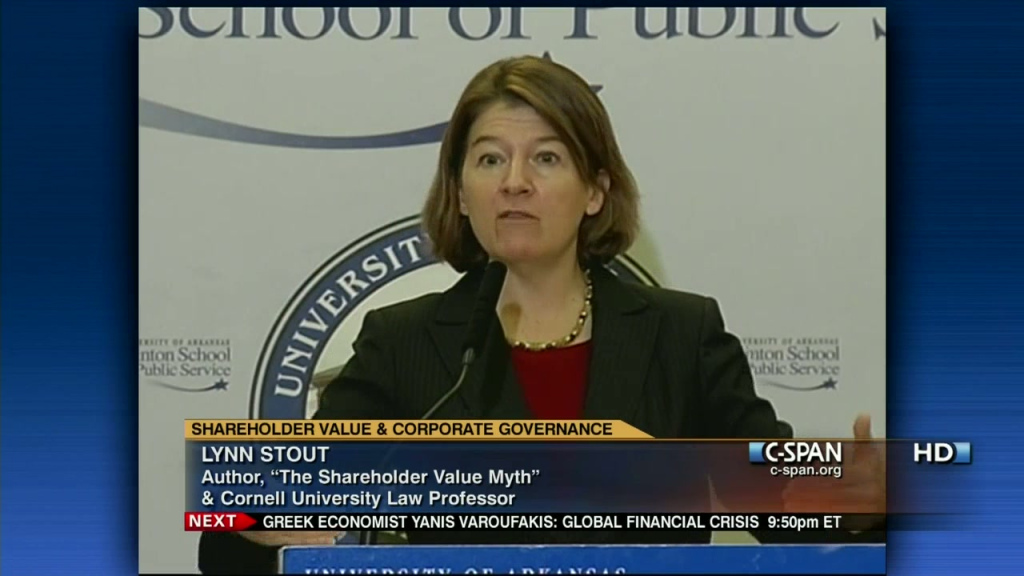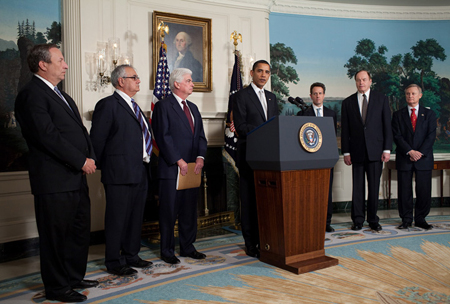
Anyone who has spent any time employed by a public company quickly learns the phrase “in the best interests of the shareholders.†It is used to justify decisions on issues including (and certainly not limited to) strategy, resource allocation, risk, personnel, marketing and reputation. “In the best interests of the shareholders†– much like that booming voice in the “The Wizard of Oz†– always bellows forth from the walled-off chambers of upper management, conveying an unambiguous intention that it should (or must) reverberate from top to bottom, ultimately finding its way into every corporate message and mission statement.

Enhancing shareholder value has become THE indispensable corporate sound bite: difficult to refute, extremely convenient and containing a uniquely disarming aura that quite successfully disguises a dangerously naïve lack of nuance. After all, if a company’s share price is going up, what could the problem possibly be, right? Shareholders and, by extension, management, employees, regulators, vendors and other constituents (pretty much anyone without a short position) ought to be happy. Besides . . . if everybody is saying it . . .
Thankfully, even when it comes to Gospel-esque axioms like shareholder value, the financial world still has fearless and eloquent contrarians. In this case, Lynn Stout, a professor at Cornell University Law School, specializing in corporate and business law, has written an insightful new book entitled, “The Shareholder Value Myth.†She boldly challenges this orthodoxy – and does so from multiple angles.
From the first page to the last, it becomes easier and easier to understand how and why Ms. Stout has earned significant stature in the world of business/legal academia. She’s certainly no pushover. Indeed, she has received serious shout-outs from some of the toughest players in the field – people like Martin Lipton, one of the original “majordomos†of bare-knuckled M&A warfare (and a co-founder of the storied Wall Street law firm Wachtell, Lipton & Rosen and Katz). Jack Willoughby, a senior editor at Barron’s is another distinguished admirer – and just one more among a phalanx of similarly formidable devotees in the fields of law, business and corporate governance.

As Ms. Stout’s title suggests, this volume’s core thesis is that dogmatic adherence to “Shareholder Ãœber Alles†(more politely known as “Shareholder Primacyâ€) doesn’t just get it wrong in the conventional sense. In reality, she argues, it can lead to disaster. Think Enron. Think Lehman Brothers. Maybe even think Fukushima or BP’s (now thoroughly deceased) “Deep Water Horizon.†This isn’t a book that pulls its punches. Ever.
Stout begins with a robust inquiry into the various legal bromides used to support the notion that public company boards are legally bound to put shareholders first in all conditions. Toward that end, she carefully dissects some of the truly game-changing cases in the history of American corporate law (e.g., Dodge v. Ford, Airgas, Unocal, MacAndrews, etc.) deftly separating dicta from binding law. Stout’s primary point here is that the “Business Judgment Rule†remains an equally critical factor in legally sanctioned corporate decision-making. Hence, when management and boards claim they’re “just following the law†by prioritizing shareholders, Lynn’s retort is that they’re actually only following part of the law. And, if you’ve ever seen what a typical Fortune 500 company pays in legal fees, then something must be seriously amiss.

Stout next bolsters her assault by punching some very large holes in the “principal-agent model†that purports to serve as the basic foundational governance structure of public corporations. In particular, she explains that three of the most commonly held assumptions about “shareholding†require immediate and substantial reevaluation:
MYTH:      “Shareholders own corporations.â€
REALITY:Â Â Corporations are legal entities in their own right. Shareholders own stock in corporations. Stock is a contract between a shareholder and a corporation that sets out a limited set of rights in a limited set of circumstances
MYTH: “Shareholders are residual claimants in corporations, meaning that they receive all profits left over after a company’s contractual obligations to its creditors, employees, customers and suppliers have been satisfied.â€
REALITY: Of course, this is really just a watered-down version of Bankruptcy Law 101 – but you’d sure never know it by listening the accepted “wisdom†spouted by our corporate elite. The fact is that (outside an actual Chapter 11 proceeding) the board of directors makes the decision on what to do with excess revenue or profits. These profits do not automatically belong to the shareholder. (They may not even be desirable! Back in the dot-com late 90’s, many investors viewed companies that paid dividends as laggards that couldn’t grow — How times have changed . . .) The board can certainly pay dividends to shareholders, but they can also decide to use excess revenue for other important efforts like retaining employees, investing in new technologies, gaining additional market share, reserving funds for losses and plenty of other functions (as long as the board is not deemed to be wasting assets).
MYTH: “Shareholders are principals who hire directors and executives for the express purpose of producing value on their behalf.â€
REALITY: That’s just not how the real world functions for public companies of ANY size. Stout notes that share price, as an indicator of management/board performance, is merely a sort of “shorthand†– and even more importantly – the ONLY day-to-day indicator (most) shareholders can look to when evaluating performance (obviously there are also annual meetings, quarterly reports, conference calls, analyst reports, etc…) Stout’s message, however, is that neither share price nor these other forms of information remotely approach the knowledge ordinarily understood to be possessed by a genuine “principal.â€
Quick thought experiment: consider the term “insider trading.†Obviously the average shareholder is not an insider anymore than the average principal could do his or her job effectively without being an insider. In sum, the word “shareholder†itself (and there’s more on this below) has grown so broad that it has ceded much if not all of its original meaning.
These myths and realities are certainly no laughing matter. Oversimplifying key relationships between shareholders, board members and management can easily infect even the best companies with a severe case of “groupthink.†It is precisely that groupthink that turns so many of our offices into “Dilbertian†bureaucracies – entities increasingly incapable of delivering on the creativity of their founders. More importantly (and distressingly), “groupthink†also risks generating inaccurate market valuations by promoting phenomena like “revenue smoothing†and other accounting and management gimmickry designed to maintain a slow, steady upward trend in share price. Moreover, there are few things more helpful for would-be fraudsters than internal misunderstandings and miscommunication.

Once the legal and factual underpinnings of the “Shareholder Über Alles†model have been thoroughly deconstructed, Stout turns her fire directly on those who continue to argue that traditional reliance on shareholder primacy wouldn’t have become so profoundly ingrained if it didn’t somehow produce better results than its alternatives. To the contrary, declares Stout, there is solid evidence – traditional or not – that unsophisticated and erroneous approaches to corporate governance and strategy are frequently the most common causes of share price destruction.
For example, Stout cites the stunningly poor decision-making within the banking sector that did so much damage during the 2008 financial crisis. In retrospect, it does indeed seem reasonable to suggest that the label “financially sophisticated individual†– applied to so many of Wall Street’s (former) titans – turned out to mean something much more akin to “financial zombie.â€
Let’s be honest – if you stumble around in the dark and can’t be stopped until you run out of flesh to eat (or have your brain removed – just a technical detail for zombie fans out there . . .) it’s a frighteningly apt description. And in 2008, it took our government far too long to begin that whole “brain removal†part of the job. Or should that have been the task of shareholders? Was management really focusing on shareholder value when they (allegedly) gave the green light signaling that internal trading desks should begin bundling sub-prime mortgages? How about using investor assets as casino chips? Again, we can now clearly see that those tempting “traditional†assumptions about corporate shareholder relationships sure don’t fare too well under the klieg lights of history.

Digging ever deeper, Stout relentlessly investigates the word “shareholder’s†loss of practical meaning. To Stout, the term’s usefulness has been diminished well beyond the basic myths about ownership and corporate structure noted earlier. The different types and motivations of shareholders are equally, if not more, vital pieces of the puzzle. Speculators, investors, high frequency funds, short-side raiders, day-traders, activists, and those holding a controlling stake (to name just a few of the varying shareholder subsets) each have widely differing goals. They exercise correspondingly differing types of behavior. Grouping such shareholders together makes as much sense as grouping animals together simply because they all happen to live in the wild. Last time I checked, lions and zebras aren’t exactly best friends. (The “long” and the “short” of the real jungle? Or is it the “short” and the “long” – one wonders . . .)
Stout also correctly emphasizes that those investors primarily driven by short-term results are not only in conflict with typical corporate governance mechanisms (devices theoretically designed to protect shareholders) but often with their fellow shareholders as well.
Surprisingly, Stout fails to mention (at least without much detail) the way in which government has also significantly altered the picture: that is by simultaneously acting as regulator and shareholder. Today, it is not at all uncommon for this complex arrangement to dominate discussions in many corporate boardrooms and executive suites. Government’s emergence as both a stakeholder in corporations (essentially overseeing the very entities from which it stands to gain or lose as a functional owner – especially in the worlds of banking and other utilities) could have used more attention. Examples from the financial world and from giant bailed out companies like GM have been front-page news since at least 2008. Notably, in each of these cases, share price simply was not the primary driver of corporate decision-making. [Forbes has a great behind-the-scenes analysis of the GM story that can be found here] In my view, further insight into how these processes affect shareholding would have been helpful and highly relevant to Stout’s larger project. Then again, I’m a curious banker and, admittedly, this is one topic probably large enough to merit its own book.

My overall take-away from “The Shareholder Value Myth†is that share price is among the bluntest of tools when evaluating the performance of a company. It merely marks a very diverse herd’s best guess as to a company’s value at one particular moment in time (Consider: is Bill Ackman or Carl Icahn really the same type of shareholder as Warren Buffett? Would they value a company the same way?) Stout and I concur that any single number is simply incapable of encompassing the immense complexity of an entity’s strategic execution and fulfillment of tactical (not to mention ethical . . .) responsibilities. The modern corporation is just too big a target with too many moving parts. Nevertheless, for many, the incessant drumbeat about the importance of shareholder primacy has too often allowed complacent thinking to rule the day.
I also strongly agree with Stout’s assertion that, wherever possible, there is real value gained by obtaining information concerning a company’s internal dynamics and its fulfillment of responsibilities toward customers, employees, vendors, regulators and the public at large. It’s amazing to me that, on the one hand, a company can state with total confidence that “The customer is always right!†yet in the same breath assert that “The interests of the shareholder are always most important!†That fact alone is one HUGE reason I believe it’s so essential for anyone running a public company to read this book.
Perhaps even more importantly, however, I’m also convinced that Stout’s explanations are equally – if not more valuable – for the employees of these corporations. Although, many of the underlying contradictions exposed by Stout’s scholarship are unlikely to change anytime soon, America’s workers surely deserve the right to know that the daily absurdity of their lives stems from identifiable policy choices – things that can be changed – and not because their fate was somehow “dropped from the sky.â€

[“Noooow…. About those TPS Reports…….”]
In no way am I suggesting Stout set out to write a “self-help book,†and “The Shareholder Value Myth†should never be categorized as such. This is a serious piece of legal and economic analysis written by an incisive thinker. Nevertheless, I don’t think it’s disrespectful at all to suggest it’s also well worth reading for anyone looking to evolve past middle management and to help build the types of less contradictory companies that our nation will require if we hope to retain a shot at global competitiveness, if not dominance. Smart business leaders, investors and advisers closely examine (and frequently reject) assumptions. That’s not a bad lesson for the rest of life either.
I think it’s fair to say that Socrates maybe went a little too far when he famously stated that: “The unexamined life is not worth living.†Even Freud decided to limit his psychoanalytic sessions on the couch to the now ubiquitous “50 minute hour.†Still, after finishing “The Shareholder Value Myth,†I’ll readily admit I did more than a little self-examination of my own. For me, the experience wasn’t just educational. It was profoundly refreshing. You can’t ask much more than that from any author.
In this important book, as elsewhere, Stout doesn’t disappoint.
You can (and should) purchase your copy of “The Shareholder Value Myth†from Amazon.com in print or electronically at the following link:

